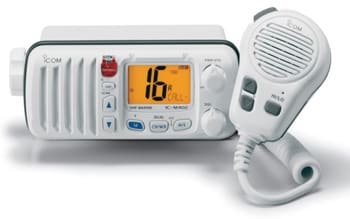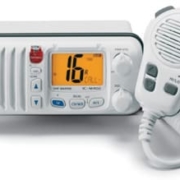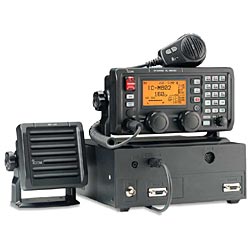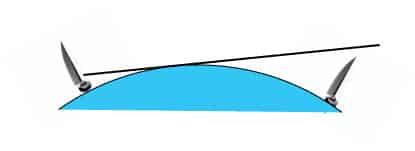Using a Marine Radio

Knowledge of using a VHF is not only mandatory for safety but some governments require a VHF knowledge certification before you can charter a boat in their waters. This section serves as that Certification. Once you complete this Bareboat Charter Clinic your NauticEd Certificate will include a VHF endorsement that you can use to show the Charter Company and the Harbor Master in those waters. Some countries will still require a license – see the next page for that information.
As Skipper of a vessel fitted with communication equipment, you have legal responsibilities regarding radio watch. These responsibilities are listed here on the USCG site at https://www.navcen.uscg.gov/radio-watchkeeping-regulations. They essentially mean that you must maintain a radio watch on the proper channels (listed below). The reason is simple – already countless lives have been saved because a responsible mariner was keeping radio watch and was able to aid in the rescue. Unfortunately, lives have also been lost when mariners did not keep watch. It’s serious business.
Fortunately, a VHF is simple to use and there are only a few things to know.
The best source of information regarding this is the United States Coast Guard. Therefore the below information is mostly reproduced from them.
But first – a little relevant humor
F stands for Frequency
In radio communications, there are a few acronyms that you should be armed with
MF – Mid Frequency. Operates in the range of 300 kHz to 3MHz. One Hertz (Hz) means the wave oscillates at a rate of once per second so 3 MHz means at a rate of 3 million cycles per second.
An HF Single Sideband Radio
HF – High Frequency. Operates in the range of 3 MHz to 30 MHz. MF and HF are typically used for radiotelephones. Single-sideband radios operate in the HF range. Because HF waves are able to bounce off the earth’s ionosphere, HF radios are typically used for carrying signals over long distances although they are susceptible to atmospheric and solar nominatives. Single Sideband was invented in the 1910s and is a method of treating the wave to reduce the power requirements for transmission.
VHF – Very High Frequency – Operates in the range of 30 MHz to 300 MHz. The wave propagation characteristics make for short-distance communication and extend slightly further than the line of sight. VHF is less likely to be affected by environmental interference. The Marine VHF range has been designated as 156 MHz Through 174MHz.
The effective transmission distance is based on the height of the transmitting antenna, the height of the receiving antenna, and the curvature of the earth. An approximation to calculate the line of sight horizon distance on Earth in miles or kilometers respectively is:
√(1.5*antenna height in feet) or √(12.7*antenna height in meters). Thus for an antenna at the top of a mast say 30 ft (9 meters) high the distance is only 6.7 miles (10.7 km). That’s not far! The range is of course extended for receiving stations that have high antennas like the Coast Guard this can be up to approximately 20 miles. Still not far!
DSC stands for Digital Selective Calling and is done via MF, HF, or VHF. It is primarily intended to initiate ship-to-ship, ship-to-shore, and shore-to-ship voice and data calls. DSC can also be to individual ships, groups, or “all stations”. Each DSC-equipped ship or group is assigned a unique 9-digit identity number. DSC distress alerts are a preformatted distress message.
Radios That You Need
It is a good idea to review the US Coast Guard marine telecomunications page.
The advantage of a VHF radio is that many people including the USCG monitor the VHF. Thus you’re likely to receive help from a coordinated effort of vessels close by. Just taking a cellular phone is not your best line of safety. Who are you going to call? Who are they going to call? How do they know who is close by you in the area?
Therefore, before you purchase anything else, make sure you have a DSC-enabled VHF marine radio. A VHF marine radio is the single most important radio system you should buy. It is probably also the most inexpensive. If you plan to travel more than a few miles offshore, as seen in the distance example above, plan to purchase an MF/HF radiotelephone or mobile satellite telephone, an emergency position indicating radio beacon, or EPIRB, and a second VHF radio or cellular telephone as well. Mobile satellite telephones are becoming more common and less expensive. The mobile satellite phone will provide easier and clearer communications than the MF/HF radiotelephone, but the HF radiotelephone will receive high seas marine weather warnings from the National Weather Service as part of NOAA.
Radio Watchkeeping Regulations
If you have a VHF-FM radio, there are certain regulations in place for monitoring/listening to your radio. And it doesn’t matter that you are a non-commercial ship operating for pleasure and minding your own business. The rules state that in general, any vessel equipped with a VHF marine radiotelephone must maintain a watch on channel 16 (156.8MHz) whenever the radiotelephone is not being used to communicate.
In doing so – it is quite likely that sometime in your maritime future, you could save lives by doing so.
Squelch Control
This control filters out static. With the unit on, turn the dial until the static sound just disappears. If you turn it too much the unit will filter out voice as well and you will not hear any transmissions.
Transmission Power
You should always use the lowest (1-watt) setting first. This reduces the broadcast distance and keeps overall interference down.
Channel 16
Channel 16 is internationally recognized and designated as the calling and distress frequency channel.
Mayday! Mayday! Mayday!…Sending a distress call
Distress calls are initiated on Channel 16 because they should be heard by many boats, as well as the Coast Guard and other shore stations within range. If you receive a distress call, cease all transmission. All vessels having knowledge of distress traffic, and which cannot themselves assist, are forbidden to transmit on the frequency of the distress traffic. They should, however, listen and follow the situation until it is evident that assistance is being provided. Transmitting may resume after hearing an “all clear” (Silence Fini).
You may only have seconds to send a distress call. Here’s what you should do:
Procedure for Digital Selective Calling (DSC) Distress Alert: Visit the DSC page on the USCG site
A distress alert should be transmitted if, in the opinion of the Master, the ship or a person is in distress and requires immediate assistance.
A DSC distress alert should as far as possible include the ship’s last known position and the time (in UTC) when it was valid. The position and the time may be included automatically by the ship’s navigational equipment or may be inserted manually.
The DSC distress alert is transmitted as follows:
- Tune the transmitter to the DSC distress channel (2 187.5 kHz on MF, channel 70 on VHF)
- If time permits, key in or select on the DSC equipment keyboard
- the nature of distress,
- the ship’s last known position (latitude and longitude),
- the time (in UTC) the position was valid,
- type of subsequent distress communication (telephony),
In accordance with the DSC equipment manufacturer’s instructions;
- Transmit the DSC distress alert
- Prepare for the subsequent distress traffic by tuning the transmitter and the radiotelephony receiver to the distress traffic channel in the same band, i.e. 2 182 kHz on MF, channel 16 on VHF, while waiting for the DSC distress acknowledgment.
Procedure for VHF Channel 16 MAYDAY:
- If you have an MF/HF radiotelephone tuned to 2182 kHz, send the radiotelephone alarm signal if one is available. If you have a VHF marine radio, tune it to channel 16. Unless you know you are outside VHF range of shore and ships, call on channel 16 first.
- Distress signal “MAYDAY”, spoken three times.
- The words “THIS IS”, spoken once.
- Name of the vessel in distress (spoken three times) and call sign or boat registration number, spoken once.
- Repeat “MAYDAY” and the name of the vessel, spoken once.
- Give the position of the vessel by latitude or longitude or by bearing (true or magnetic, state which) and distance to a well-known landmark such as a navigational aid or small island, or in any terms which will assist a responding station in locating the vessel in distress. Include any information on vessel movements such as course, speed, and destination.
- Nature of distress (sinking, fire, etc.).
- Kind of assistance desired.
- The number of persons onboard.
- Any other information that might facilitate rescue, such as length or tonnage of the vessel, number of persons needing medical attention, color hull, cabin, masks, etc.
- The word “OVER”
Stay by the radio if possible. Even after the message has been received, the Coast Guard can find you more quickly if you can transmit a signal on which a rescue boat or aircraft can home.
For example:
MAYDAY-MAYDAY-MAYDAY
THIS IS BLUE DUCK-BLUE DUCK-BLUE DUCK WA1234
MAYDAY BLUE DUCK
OUR POSITION IS CAPE HENRY LIGHT BEARS 185 DEGREES MAGNETIC-DISTANCE 2 MILES
OUR CONDITION, WE HAVE STRUCK A SUBMERGED OBJECT
WE REQUIRE PUMPS-MEDICAL ASSISTANCE AND TOW
THERE ARE THREE ADULTS AND TWO CHILDREN ONBOARD
ONE PERSON HAS A COMPOUND FRACTURE OF ARM
ESTIMATE CAN REMAIN AFLOAT TWO HOURS
BLUE DUCK IS THIRTY-TWO FOOT CABIN CRUISER-WHITE HULL-BLUE DECK HOUSE
OVER
Repeat at intervals until an answer is received.
One thing to keep in mind is that you may know how to make a MAYDAY call but your crew may not. Therefore Download this Mayday Call document – laminate it and put it on your boat near the VHF radio. Or download this smaller version, laminate it, and zip-tie it to your VHF mic cord.
If you hear a distress call…
If you hear a distress message from a vessel and it is not answered, then you must answer. If you are reasonably sure that the distressed vessel is not in your vicinity, you should wait a short time for others to acknowledge.
MF/HF Radiotelephone
Your VHF radio is intended mainly for short-range communications, generally 5-10 miles, and at least 20 miles to a USCG station. To communicate at longer ranges, you will normally need a satellite telephone or an MF/HF marine radiotelephone. HF Marine radiotelephone equipment normally operates between 2 – 26 MHz using single sideband emissions. MF/HF marine radiotelephones can also be used to receive high seas weather broadcasts, and by using a computer and a special interface provided by some coast stations, can provide Internet email.
What to do if no one responds to your distress call
Tune your HF radiotelephone to an HF channel guarded by the Coast Guard, and repeat your mayday call – but note there are some limitations these days in monitoring.
Calls Other than Distress
Urgency: “PAN, PAN, PAN” (PAHN PAHN PAHN). This is the International Urgency Signal and is used when a vessel or person is in some jeopardy of a degree less than would be indicated by Mayday.
Safety: “SECURITY, SECURITY, SECURITY” (SAY-CURE-IT-TAY). This is the International Safety Signal and is a message about some aspect of navigational safety or a weather warning. You will most often hear this from the Coast Guard. Listen and take appropriate actions if necessary. For example, perhaps a navigational aid has drifted off station or a tornado watch has been issued.
General Calls to Other Ships or Shore
The frequencies/channels that you may use as a recreational boater are the channels listed as non-commercial, channel 16 for initiating calls and for distress calls. In the USA you can also use Channel 13 to contact commercial vessels in the case of a potential collision. Commercial vessels are required to monitor channel 13 as well as 16.
For HF, see the High-Frequency Radiotelephone webpage.
For VHF see the VHF Channels page. Note carefully the channels you as a recreational non-commercial boater can use to communicate. Each Channel operates on a different VHF frequency. Here is a summary.
- Channel 09 – Boater Calling. Commercial and Non-Commercial.
- Channel 13 – only in the case of a potential collision with a commercial vessel.
- Channel 16 -International Distress, Safety, and Calling. Any ships that are required to carry a VHF radio, the USCG, and most coast stations maintain a listening watch on this channel. i.e. if you carry one you are required to maintain a watch.
- Channel 68 – Non-Commercial traffic
- Channel 69 – Non-Commercial traffic
- Channel 71 – Non-Commercial traffic
- Channel 72 -Non-Commercial (Intership only)
- Channel 78A (Channel 1078*) – Non-Commercial traffic
- Special Note – Channel 70 is for DSC calling only No voice is allowed.
- WX1 Through WX7 are weather broadcasting channels. They are listen-only channels. No transmission is possible. The frequency range is slightly higher than any of the Channels 1 through 88.
All others are for port operations, commercial traffic, government, etc. Note in particular, Channel 70 is for DSC distress signals. No voice is allowed on Channel 70. Sometimes you’ll see an “A” and “B” switch. A is typically used in the US. B is used in cases other than the US ( sometimes labeled as “international”).
*In more modern VHF systems the “A” is disappearing and “10” is placed in front of the old “A” channel. e.g. channel 78A is replaced with 1078. “B” is replaced with “20” in the same manner. Thus you will no longer see an “International / US” switch on the unit.
Procedure for Calling A Ship by Radio
You may use channel 16 to call a ship or shore station, but if you do so, you must, must be brief! We recommend this same procedure be used over channel 9, if channel 9 is used as a calling channel.
For example:
Blue Duck: “Mary Jane, this is Blue Duck” (the name of the vessel or MMSI being called may be said 2 or 3 times if conditions warrant)
Mary Jane: “Blue Duck, this is Mary Jane. Reply 68” (or some other proper working channel)
Blue Duck: “68” or “Roger”
Both switch to channel 68 (as an example). Have the conversation. End each turn with “over”. End the conversation with your station name and “out”.
Global Maritime Distress & Safety System
VHF maritime channel 70 (156.525 MHz) is authorized exclusively for distress, safety, and calling purposes using digital selective calling (DSC) techniques. No other uses are permitted.
Channel 70 is used to send distress alerts, safety announcements, and for calling purposes under the Global Maritime Distress and Safety System (GMDSS). Many vessels are now equipped with DSC capability and are using channel 70 for this.
Storm Warnings?
The Coast Guard announces storm warnings and other urgent marine information broadcasts on VHF channel 16 and 2182 kHz before making the broadcasts on VHF channel 22A and 2670 kHz respectively. Storm warnings and forecasts are also made by NOAA .
MAYDAY Radio Checks and other Hoaxes
Every hoax, including MAYDAY radio checks, is subject to prosecution. In the United States, it is a Class D felony under Title 14, Section 85 of the U.S. Code. Violators are liable for a $5000 fine plus all costs the Coast Guard incurs as a result of the individual’s action. Since hoaxes can lead to loss of life, the Coast Guard and Federal Communications Commission will work closely together, using when necessary FCC equipment capable of identifying the electronic signature of the offending radio. We ask your cooperation in helping us and the FCC remove hoaxes from the VHF radiotelephone distress, safety, and calling channel 16.
Radio Checks
Radio checks with the Coast Guard Communications Stations on DSC and HF radiotelephone are allowed but not on VHF.
Satellite Communications
Currently, the Inmarsat Organization, an international organization established by treaty, is the sole provider of worldwide maritime mobile satellite communications offering emergency calling capability. Coverage is available between about 70 deg N latitude and 70 deg S latitude. Other mobile satellite systems are also becoming available, but these systems, in general, do not offer an emergency calling capability.
For More Information…
See the USCG site at https://www.navcen.uscg.gov/maritime-safety-information
The Phonetic Alphabet
Whenever you are using voice to transmit letters you should use this international standard that corresponds words to letters.
| Alpha | Echo | India | Mike | Quebec | Uniform | Yankee |
| Bravo | Foxtrot | Juliet | November | Romeo | Victor | Zulu |
| Charlie | Golf | Kilo | Oscar | Sierra | Whiskey | |
| Delta | Hotel | Lima | Papa | Tango | X-Ray |
Hint – the test with this section requires you to memorize these.
The Yacht Charter Base
Most of the time on a chartered vacation, you will be out of VHF range of the Yacht Charter Base If you want to communicate with them they will typically give you their telephone number. In most charter vacation destinations, your cellular telephone will work however international roaming phone rates apply which are VERY expensive. You can easily save ten times the cost of this course by calling your carrier before your vacation and signing up for an international roaming deal. Be especially aware of pulling in Data via your phone. Costs vary but are about $10 per megabyte. It’s best to turn data off. You can usually hit an internet cafe on one of the islands to catch up with important emails.
Typically, your Yacht Charter Base will designate a channel other than 16 to communicate with you upon your imminent return to base. They will require you to call them on this channel when you are within about 3 miles of the Base. They will give you instructions as to which dock you should return your vessel to along with other instructions. Sometimes they will require a harbor captain to come out to your ship to steer you in. For example, in St. Maarten, the entrance to Oyster Pond is a little tricky with breaking waves.
Your conversation here would sound like the following.
Switch to Designated Channel
YOU: “XYZ Charter Company, this is Blue Duck Over”
BASE: “Blue Duck this is XYZ Charter Company. Over”
YOU: “XYZ Charter company, we are approximately 3 miles due south and returning to Base. Request docking instructions. Over”
BASE: “Blue Duck, Dock your vessel in slip Bravo five. Stern to. Over”
YOU: “Slip Bravo five. Stern to. Blue Duck out”
(Note, if you’re worried about “stern to” docking, take our Maneuvering Under Power Clinic and never worry again)
Other Information Via VHF
Be sure to ask your Charter base about which channel and times the weather forecast will be broadcast. Typically these are set at specific times every day. Obviously, it is imperative that you be able to listen to these broadcasts. The harbormaster in each port that you visit is also a good source for weather forecasts and weather maps.
News: Once on a trip in the Sea of Cortez we were delighted to receive a broadcast of a completely biased and commented summary of the world news every day at 9:00 am by a local group of ex-pats living on their boats. Check with your Charter company – they’ll know what is going on via the VHF.








